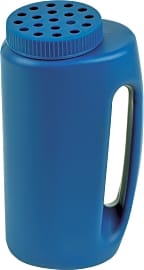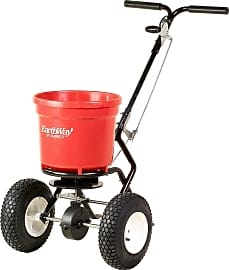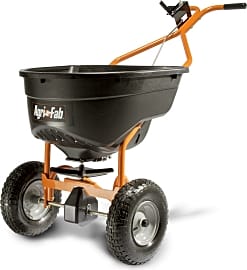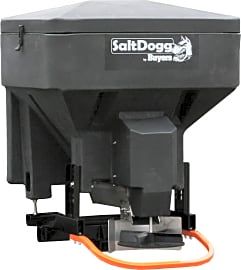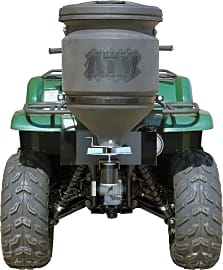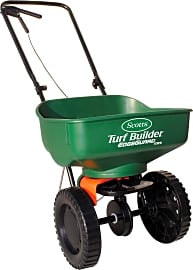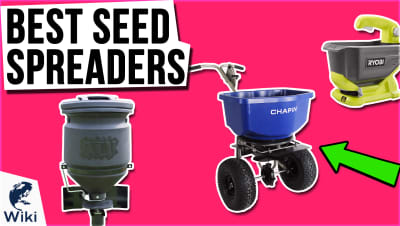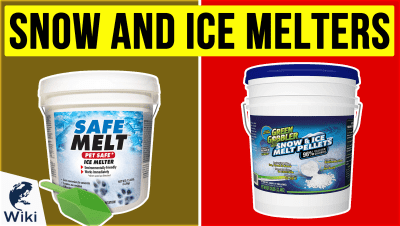The 8 Best Salt Spreaders

This wiki has been updated 36 times since it was first published in September of 2016. Whether you are aiming to keep your walkways and driveways clear of snow and ice this year to avoid any nasty falls or you have a large property with extensive pavement on it, we've got you covered. Our selection of salt spreaders includes something for everyone, from the homeowner right up to city and county maintenance departments, ranked here by capacity, spread, and durability. When users buy our independently chosen editorial recommendations, we may earn commissions to help fund the Wiki.
Editor's Notes
July 09, 2021:
No changes to report in the world of salt spreaders these days. The Chapin International 8400C is the best walk-behind model for medium to large applications although the Earthway 2150 is a bit better for uneven ground. Meanwhile, the handheld Home-X Dispenser is ideal for small walkways. If you have a ton of ground to cover, the bumper-mounted SaltDogg TGS03 can certainly help you get through quickly, although it's incredibly expensive.
March 30, 2020:
While there is inevitably going to be some crossover between this list and our ranking of seed spreaders, it's important to remember that the size and hardness of ice melt is often larger and more rigid than the average seed, making it necessary for our selections here to offer a high degree of durability. There's also not much use for something like the SaltDogg TGS03 on a plot of land, unless you want to till the soil with its tires (we don't recommend this). It is, however, an incredibly capable option for roadway use, with a generous hopper and a control unit that lives in the cab with you, so you don't have to get out and make manual adjustments as road or weather conditions change.
We added the Chapin International 8400C, largely as a replacement for the similarly sized Earthway model from our last list. The Chapin boasts superior durability, as the Earthway had issues with the lifespan of its gearbox, which saw significant strain when the unit was used with salt. It's for a similar reason that we got rid of the Scotts Wizz, as the power generated by its battery was okay for seed use, but not quite enough to distribute melt reliably, and bested by the simplicity and reliability of the Home-X Dispenser.
Wait, Why Are We Spreading Salt?
“See that garbage can full of salt? That’s where he keeps his victims.”
Even though I watched the cinematic masterpiece known as Home Alone approximately 147 times between the ages of five and 10, one scene never failed to confound me: Kevin McAllister’s introduction to Old Man Marley as he spreads salt in the neighborhood.
“He walks up and down the street every night, salting the sidewalks,” Buzz cryptically tells Kevin. “See that garbage can full of salt? That’s where he keeps his victims.”
At first, the South Bend Shovel Slayer terrified me. But then I got to thinking: why is he wasting good salt on the sidewalk? What’s the point? Of course, it wasn’t until years later that I discovered the true use of road salt. Truth be told, it was a bit of a let-down.
People apply salt, also known as sodium chloride, to roads, sidewalks, and other types of pavement to combat snow and ice, thereby making the surfaces less slippery. The chemical process is actually rather simple: when water freezes, the loose molecules within the water position themselves in a more compact, structured way. Salt disrupts this process by acting as an impurity in the water, disrupting its ability to form ice.
The addition of salt decreases the temperature at which the water will freeze. The more salt you dissolve into the water, the lower its freezing point becomes. For example, instead of freezing at 32 degrees Fahrenheit, the salted solution may not freeze until the temperature reaches 22 degrees Fahrenheit.
Whatever salt compound you choose, you are spreading it to accomplish one of two things: de-icing or anti-icing. When you de-ice a surface, you’re eliminating snow or ice that already exists. When you anti-ice, you’re taking a more preventative approach, as you intend for the solution to remain on the surface for a certain period of time to continuously delay the formation of ice or frost.
What To Look For In A Spreader
If you’re new to de-icing, you’ll quickly learn that applying salt is not a simple task. There are so many issues to consider: the size of the job, the amount and type of materials you need, the strength and durability of your equipment, and a location to store everything. If you’re looking at tailgate or hopper models, you’ll also need to consider the ease of attaching the spreader to your vehicle, the feed system you’ll use, the design of the motor and spinner, and the type of chute you require.
If the answer is limited to your own property or similar residential applications, you don’t need to worry about hopper and tailgate models.
Overwhelming? It may seem like it now, but you should be able to narrow it down to a few suitable choices pretty quickly. First, ask yourself this: where will you use this spreader? If the answer is limited to your own property or similar residential applications, you don’t need to worry about hopper and tailgate models. And, if you only need to de-ice a little patio or walkway, just go with a handheld model and call it a day.
For use on small driveways, sidewalks, decks, and walkways, a simple walk-behind, tow-behind, or snow blower spreader will suit your needs fine. To use a walk-behind, you simply push it like a lawnmower, which prompts a set of gears to turn and dispense the salt. If you own a lawn tractor, you can attach a tow-behind model to its hitch, and it will function in a similar fashion. Snow blower spreaders integrate with your snow blower, as long as the brands are compatible.
If you maintain large parking lots or roadways, an insert hopper spreader or larger capacity tailgate spreader will be the way to go. For driveways and lighter applications, a small to mid-size tailgate spreader will get the job done. Regardless of size, durability and resistance to corrosion are important aspects to consider. Spreaders constructed with stainless steel or polyethylene are usually reliable.
You should also think about the type of material you intend to dispense. Bulk rock salt and other materials comprised of large chunks will require a hopper or tailgate spreader. Snow and ice melting solutions made with finer materials are suitable for small- to mid-capacity units.
The Art of Salt Application: Safety and Efficiency
Icy conditions cause thousands of deaths and injuries each year, but those of us who live in cold-weather climates often take salted roads for granted. Plus, snow and ice don’t only affect the safety of drivers; in some states, the daily economic costs of road closures due to wintry conditions can reach into the hundreds of millions.
Of course, you should avoid driving in hazardous conditions if possible.
To implement an effective de-icing program, safety and efficiency are key. If you’re working with a small unit at home, you can begin by using a shovel or snow blower to get rid of any snow that has accumulated. When you do begin the de-icing process, make sure to wear protective gloves. Ideally, you should keep kids and pets inside as you apply the solution.
When you’re about to embark on a commercial job, ensure that the model of your spreader and the amount of salt materials you’re dispensing are compatible with your truck. If you have a larger hopper or tailgate spreader, confirm that your vehicle can manage the load. If you will handle multiple jobs in a single outing, remember that the larger the capacity, the less frequently you’ll have to return for a refill. That being said, hauling extra materials can lead to higher fuel costs, so you’ll need to be strategic in your decision-making.
Of course, you should avoid driving in hazardous conditions if possible. However, if you do find yourself out applying salt on a slick roadway, you can take some tactical precautions. Make sure your tires are properly inflated and that your gas tank is at least half full, as the last thing you want to do is get stranded in dangerous winter conditions. You should also avoid using cruise control, accelerate and decelerate slowly, and allow for plenty of room between you and the vehicle ahead of you.


